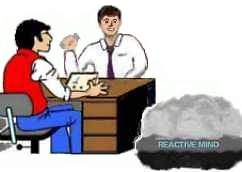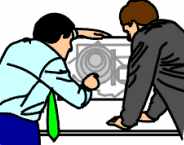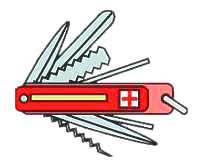Barriers to Study |
||||||||||||||
|
There are three distinct phenomena that form barriers to study. The description of these three types of barriers and how to overcome them are an important part of this manual, "Study Manual - Study and Application". Each barrier result in a type of mental and
psychological reaction in the student.
(1) Lack of Mass: The actual mass of the subject is missing. If a student is taught to repair cars and never shown a motor or even pictures of parts, or the tools and materials used in car repair, we have a typical example of lack of mass.
(2) Too Steep a Gradient: One is going ahead to the next step before mastering the previous one. This phenomenon applies especially to doingness, but also to understanding. If a student is studying barn building he could be taught all about power tools before mastering the basics of carpentry and the whole subject would be too confusing. This would be an example of too steep a gradient.
(3) Bypassing Misuderstoods: The third barrier to study is the most important one. It is bypassing undefined words or misunderstanding words. This apparently innocent oversight can cause the most serious reactions on the part of the student. Understanding a text, whether the written word or spoken instructions, depends utterly upon the student understanding all the words. The moment the student goes past misunderstood words and symbols he will experience a 'mental blank' and find the instructions incomprehensible. When this accumulates due to many misunderstoods he will find the whole subject incomprehensible and become hostile to it. 1. The Lack of Mass Let's say the student is given a text on how to repair cars but no pictures are included and the student isn't allowed to go near a car. The whole thing will soon seem very theoretical and weird to him. Reactions: He will typically experience one or more of these reactions: It will make him feel squashed, it will make him feel spinny and confused; he can experience a 'dead' feeling, feel bored, or exasperated. He is desperately trying to figure out what the text refers to, trying to visualize the parts and actions described and this is very hard in the absence of any pictures or mass. The mass is especially important in studying practical subjects. When a student is learning how to repair cars he needs illustrations, photographs, videos, and actual car parts and tools he can touch and handle. If you try to teach him car repair by only using printed or spoken words he will end up with a headache or his stomach feeling funny. His face may feel squashed, he may become dizzy, and his eyes start to hurt. Much of these reactions stem from his efforts to visualize what he is being told. But since he has to create it all as mental pictures it will cause a lot of mental and physiological reactions. This type of education taken to its extreme can cause the student serious doubts about his capabilities and his very beingness. It's a sad fact that student suicides are more common in fields taught in this manner. In less extreme cases it can cause illness in school children and adult students as well.
Remedies: Remedies given in this manual are: using pictures and videos to show parts and tools of the subject taught. Also having the student doing demonstrations by representing tools and parts with small objects. Important parts and principles should be demonstrated in clay. The student simply makes a representation in clay of the things described and labels each part. Another simple remedy is to have the student do Reach and Withdraw on physical objects involved. Let's say he is learning about car motors. Under supervision he is simply made to touch parts of a motor pointed out by another student. Each time he touches that part he is acknowledged and a new part is chosen. The student running this drill would simply point out a part and not demand the student explain anything about it but simply have him touch it. By keeping this up for a while the student will feel his 'lack of mass' is being repaired and will feel more relaxed and happy about the whole subject. As a result much or all of the described symptoms will disappear.
2. Too Steep a Gradient Reactions: If you push a student along on too steep a gradient he will experience one or more of the following mental and physiological reactions: confusion, disorientation and being spun around. The parts he is trying to learn seem to be less solid and in random motion. Too steep a gradient means it was too much of a
jump. He didn't understand what he was doing or was supposed to do and he
was started on the next step or skill level. Routinely he will feel the
new level is where his difficulties are. He will assign it all to this new
level. But the truth is that is was on the previous level. The remedy is
to put him one step back and really make him able to perform that skill
well. The actual missed gradient was at the tail end of the previous
level. As stated, this applies especially to doingness, to practical
actions. Remedy: The remedy is to put him back on the step he didn't master. Have him practice using the wrenches on different knots and bolts without adding the complexities of a whole motor to it. Is he holding the wrench right? Does he know what to do to overcome a resistant knot or bolt? Does he know how to loosen up a rusty bolt with chemicals, and so on? Sometimes an instructor has to be inventive in realizing what simpler skills go into a more complicated skill. Maybe the materials themselves did not predict the type of difficulties and missing skills the student could get hung up on. A good instructor will be able to remedy this and break a complicated action down into the component parts. He then has the student practice each little skill before he is made to put it all together. Instructors mastering this little point are often looked upon with awe as they can teach the "most clumsy and stupid students" to become competent. It does take an ability to observe and analyze, but it really does not take genius to overcome these things as an instructor. This phenomenon of the skipped gradient is somewhat similar to the last phenomenon, the misunderstood word, but it stands alone as it is not rooted in misunderstood words, but in too much motion or randomity for the student to handle. It's the complexity of the action that throws him off. 3. Bypassing Misunderstoods
Symptoms: Bypassing a definition gives the student a blank feeling or washed out feeling. It is a sort of 'not-there' feeling. It can develop into a nervous hysteria, sleepiness (even completely falling asleep), or utter non-comprehension, and violent disagreement with even simple facts. Ultimately this barrier is what is behind students that 'blow', meaning they leave course or give up on the study that otherwise seems very beneficial to them. The student may not necessarily blow as a result of the first two phenomena. They may make him feel uncomfortable mentally and physically, but they don't produce blows. It takes bypassed definitions to bring that about. The bypassed definition is the most important barrier. It affects human relationships, the mind, and subjects. It is a prime element of aptitude or lack of aptitude and itís what psychologists have been trying to test for years without knowing exactly what it was. Itís the definitions of words. Misunderstood words and symbols. Thatís all it goes back to. This produces a vast variety of mental effects and is all by itself the prime factor involved in stupidity and the prime factor involved in many other mental phenomena. If a person didnít have misunderstoods in a subject he could perform in that field. His talent might or might not be present but his doingness would be present.
An utter inability to perform the actions in a field is a result of misunderstood words in that field. If we take the task of pastry cooking we can't say Joan would be as good a pastry cook as Ann, but Joan's inability to approach pastry making is ultimately based on having misunderstoods in the subject of cooking or pastry cooking. There were some words in the subject of pastry cooking that the inept person (Joan) didn't define or understand. This was followed by an inability to perform in that field. This is a very important datum, because it tells us what happens regarding doingness and that the restoration of doingness depends only upon the restoration of understanding, on clearing up the misunderstood words or missed definitions. Remedy: The remedy is quite simple, fast and, easy to do. It consists of clearing the misunderstood words and definitions and have the student restudy the materials. The difficult part can be to find these misunderstoods. There exist a number of methods of Word Clearing that takes this up. The manual describes and defines these methods and gives exact instructions on how to do the most common ones (there is a short description of them all in the glossary). You can trace these misunderstoods back in subjects the student got dumb in and often back to earlier related subjects. Clearing up the misunderstoods opens the door to education and understanding. Then re-doing the subject with knowledge about these three barriers to study makes it possible for the student to become competent and actually perform in the field. And that is what the Study Technology and this manual is all about.
|
||||||||||||||

















